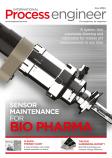Festo has developed a self-adjusting pneumatic cushioning system that is now available as a build-to-order option for the company's popular DSNU series round cylinder pneumatic actuators. The new system employs innovative, patented air channel geometry to provide phased venting of the cushioning air. The system automatically adapts its characteristics to suit the cylinder's prevailing load and speed conditions to provide optimum end-position cushioning.
Festo is initially offering the new self-adjusting cushioning system on its popular DSNU cylinders. Models available with the new system span diameters from 16 to 63mm, with stroke lengths up to 500mm. Delivery is usually within 24 hours. The DSNU series of pneumatic actuators already offers users a choice of polymer (P) or manually-adjustable pneumatic (PPV) end-position cushioning for applications involving low- and high-impact energy levels, respectively. The new self-adjusting (PPS) cushioning is intended primarily for medium impact energy applications involving loads up to about 5kg and speeds up to approximately 1m/s. PPS cushioning is also available on Festo's CRDSNU corrosion-resistant stainless steel round-line cylinders, which offer the additional benefit of cleaner lines for improved wash-down by eliminating any potential for dirt entrapment around a cushioning screw.
Because the exhaust flow of the pneumatic cushioning chamber changes over the damping stroke, Festo's PPS system works with most commonly permissible speed and mass combinations, making it suitable for a wide range of applications. Steve Sands, Festo's product manager, states: "Round cylinders account for a significant proportion of our pneumatic actuator sales, and about 60 per cent of the DSNU cylinders that we sell are equipped with PPV cushioning; of these, about 80 per cent are used for applications that would benefit directly from our new PPS self-adjusting cushioning. Given that the PPS system actually costs less than our manually-adjustable technology, saves setting-up time and is always providing the optimum cushioning, we expect it to be a very popular choice with machine builders."
The advantages of self-adjusting end-position cushioning are considerable. Manually adjusting the end-position damping of linear actuators is time-consuming and can only be done effectively once the actuator is in-situ and under operating load conditions. By then the automation supplier is invariably under pressure to complete the task as quickly as possible. It also frequently involves two people - one to operate the appropriate pneumatic valve, the other to adjust the actuator's damping characteristics. As with all moving parts, access can be potentially hazardous, which means that safety considerations dictate that only experienced personnel should perform these adjustments. Actuators are often less than perfectly adjusted, with under-damping resulting in higher end-position impacts, higher noise levels and increased wear, or with over-damping resulting in increased machine cycle times.
Festo estimates that, on average, the PPS self-adjusting end-position cushioning system will help users save five minutes from a cylinder's installation and set-up time. For a typical application, such as a package sorting system with, say, 60 cylinder-driven routing stations, this would result in savings of five man-hours.
Festo's PPS self-adjusting end-position cushioning is a 'fit and forget' product; since it has no settings to change, it is completely tamper-proof and it offers a long, maintenance-free service life. Festo DSNU pneumatic cylinders equipped with the new PPS system are 100 per cent interchangeable with the company's manually-adjustable DSN-PPV models.
For more information, visit www.festo.com
Round cylinders feature self-adjusting pneumatic cushioning
Paul Boughton


















